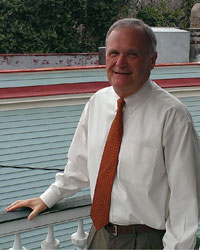Robert Gurley, Director of Advocacy at Preservation Society of Charleston, South Carolina
 Robert Gurley graduated from the University of North Carolina at Chapel Hill with a B.A. in American History. Gurley worked on his Master’s in Applied History at the University of South Carolina. He is a native of Roanoke Rapids, North Carolina. Before joining the Preservation Society of Charleston, he worked for a North Carolina bank as a loan officer for 12 years. He is currently the Director of Advocacy at the Preservation Society of Charleston and has worked there for 19 years.
Robert Gurley graduated from the University of North Carolina at Chapel Hill with a B.A. in American History. Gurley worked on his Master’s in Applied History at the University of South Carolina. He is a native of Roanoke Rapids, North Carolina. Before joining the Preservation Society of Charleston, he worked for a North Carolina bank as a loan officer for 12 years. He is currently the Director of Advocacy at the Preservation Society of Charleston and has worked there for 19 years.
What led you to the preservation field?
Robert Gurley has a love for history. Growing up in a small town in North Carolina, about two hours from Jamestown and Williamsburg, he was able to take numerous day trips to these historic sites. Reflecting on his childhood, Gurley remembers numerous remodeling projects in his neighborhood, such as timber framing or brick and masonry construction. Then, Gurley became a history major and realized that buildings were something people use to identify themselves. After this discovery, his interest in history, building, construction, and processes grew.
Do you think preservation education matters? If so, why?
Gurley said, absolutely! If you are serious about historic preservation as a field, than you need more than an interest in buildings, you need an academic framework. There is a need to understand the Acts, NHPA 1966 and the ones after and before, like 1906. It is so helpful to be around colleagues who are interested in these ideas as well. Taking a course in educating the public is great, because we have so many citizens interested in preservation from other fields that need a point of reference.
What courses do you recommend for students interested in this field?
Urban planning, historic preservation, architecture. Students need more hands on construction methods. Learning about National Register nominations and tax credits is great stuff, but the hands on, brick and mortar projects would be great things to emphasize. Taking a look at zoning, it plays such an important part of what the built environment looks like. If the zoning is wrong, then you’ve lost half the battle at the architecture review. Taking more courses in construction, building materials, and arcane issues, like zoning.
Do you have a favorite preservation project? What about it made it special?
Yes, I do have a favorite project. The [Preservation] Society just purchased 227 Nassau. It has been a long time since the Preservation Society owned a building. So, we are able to go do our building the way we want instead of working with owners, architects, contractors, etc. I didn’t realize how much time I spent looking at new construction, dealing with new construction. I spent a lot of time with these big grand houses, but really the vernacular projects are more fun.
Can you tell us what you are working on right now?
We have a “Seven to Save” each year. Right now we are working with Magnolia Cemetery’s receiving tomb. This is where the arrangements were made before the embalming process. We are working with structural engineers and architects to redesign it. There are a lot of meetings, architectural reviews, etc. Business is picking back up, which is a good and bad thing. It’s good because the bad projects die out, or lose funding and hopefully they won’t get picked back up. Funding is dropped for a lot of projects during recession. I am working with DAR, zoning, planning commission, and city council. We’re always talking to contractors and architects, builders, and homeowners.
Do you have advice for novice preservationists?
Get as wide a variety of experience as you can. Don’t turn down an opportunity that is connected to preservation. Be flexible in what your career might be, because you’re in a great one. It is not a high growth field, but don’t miss those opportunities to show what you can do.
The ACHP’s motto is “preserving America’s heritage;” how is your community preserving their heritage?
Charleston cares about its built environment. The Preservation Society has played a part since the 1920s. There are a lot of people passionate about historic preservation. The citizenry is passionate, and they care about the community. It brings a lot to the discussion and hopefully turns out better projects in the process.
Read more Q&A stories about the Preservationists in Your Neighborhood!